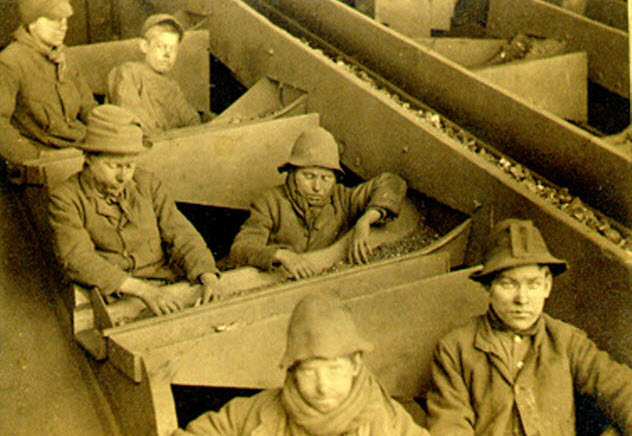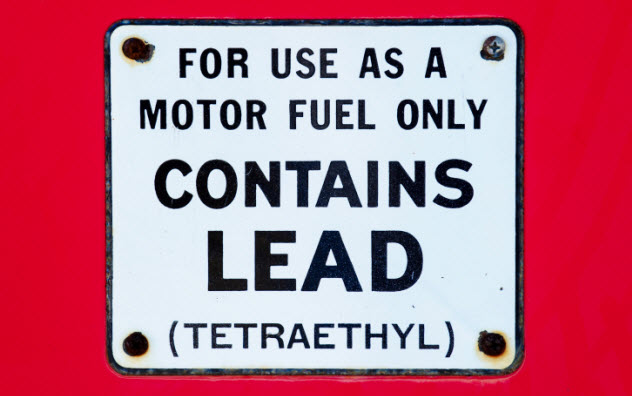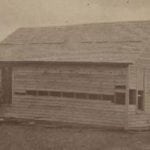 Food
Food  Food
Food  History
History 10 Odd Things Colonial Americans Kept at Home
 Weird Stuff
Weird Stuff 10 Superstitious Beliefs That Once Consumed Entire Cultures
 History
History 10 Bizarre Friendly Fire Incidents in Military History
 Technology
Technology 10 Modern Technologies That Accidentally Imitate Ancient Magic
 Mysteries
Mysteries 10 Mysteries of the Human Genome
 Weird Stuff
Weird Stuff 10 Things So Rare They’ve Only Been Found Once
 History
History 10 Legends Whose Last Moments Undid Their Glory
 Health
Health 10 Futuristic Ideas to Treat Common Medical Problems
 Weird Stuff
Weird Stuff Ten Surreal Attempts to Reverse Baldness
 Food
Food 10 Everyday Foods You Didn’t Know Were Invented by the U.S. Military
 History
History 10 Odd Things Colonial Americans Kept at Home
 Weird Stuff
Weird Stuff 10 Superstitious Beliefs That Once Consumed Entire Cultures
Who's Behind Listverse?

Jamie Frater
Head Editor
Jamie founded Listverse due to an insatiable desire to share fascinating, obscure, and bizarre facts. He has been a guest speaker on numerous national radio and television stations and is a five time published author.
More About Us History
History 10 Bizarre Friendly Fire Incidents in Military History
 Technology
Technology 10 Modern Technologies That Accidentally Imitate Ancient Magic
 Mysteries
Mysteries 10 Mysteries of the Human Genome
 Weird Stuff
Weird Stuff 10 Things So Rare They’ve Only Been Found Once
 History
History 10 Legends Whose Last Moments Undid Their Glory
 Health
Health 10 Futuristic Ideas to Treat Common Medical Problems
 Weird Stuff
Weird Stuff Ten Surreal Attempts to Reverse Baldness
10 Disturbing Exposes That Transformed Society
Beginning with the Progressive Era of US history (c. 1890–1920), writers have used the power of the pen and mass media to uncover the ills of society and call for reform. President Theodore Roosevelt coined the term “muckraker” to describe such reformers, a reference to John Bunyan’s Pilgrim’s Progress in which a rake is used to dig up muck and filth. The muckraking tradition has become part of investigative reporting and still has an impact to this day.
10 A Mad World And Its Inhabitants
1872

Bloomingdale Asylum was a private hospital for the mentally ill in New York where Columbia University now stands. An exclusive institution for patients from well-to-do families, the peaceful, well-kept grounds belied the horrors going on inside.
As rumors of patient abuse circulated, Julius Chambers, one of the world’s first investigative journalists, determined to discover the truth by going undercover as a patient in Bloomingdale Asylum. To feign insanity, he deliberately cut down on food and gorged on stimulants like cigars and coffee, intending to abstain shortly before his assignment. He calculated that the sudden withdrawal would disrupt his nervous system and make his act more convincing.
Chambers fooled the doctors who examined him, and he was immediately sent to Bloomingdale. With its population of about 200 patients, the hospital was staffed by only three doctors and 10 attendants, who largely ignored patients in distress or slapped them and left them to suffer alone in their squalid, prison-like cells. Chambers was admitted to the “manic wards” of unlighted padded cells, each measuring 2 meters (6 ft) by 3 meters (9 ft).
Chambers described the experience in his expose:
No means was ever resorted to which proved so effectual in breaking the will, destroying hope, and inspiring madness as solitary confinement in a cell whose walls or ceiling were bare of a single object to direct the thoughts or the attention of the unhappy prisoner. The dungeons of feudal Germany, revolutionary France, or inquisitorial Spain, were no better calculated for these results than was the cell in which I found myself immured.
Barely edible meals were served with dirty knives and forks. An attendant “fed the animals” (his words) in solitary. Patients had no contact with the outside world, not even through newspapers. Chambers couldn’t believe that wealthy patients were treated this way.
After 10 days in hell, Chambers’s newspaper obtained his release. His expose, released in installments over two weeks, prompted New York Governor John Hoffman to launch an immediate investigation of Bloomingdale and other asylums. As a result, 12 sane patients were released, and the asylum was completely reformed.
In 1872, Chambers collected his experiences into a book, A Mad World and its Inhabitants. It ultimately changed the way government viewed “lunatics.”
9 A Century Of Dishonor
1881

In 1879, poet and author Helen Hunt Jackson heard a lecture by Native American Ponca Chief Standing Bear in Boston. Forced out of their small reservation in the Dakota Territory and into the Indian Territory in Oklahoma, Standing Bear’s tribe was poorly housed and prey to disease. President Rutherford B. Hayes ignored their plight—a death sentence for over 100 Ponca, including Standing Bear’s son.
Deeply moved, Jackson was determined to use her literary gifts to awaken the American public to the mistreatment of Native Americans. Her subsequent research uncovered evidence of longstanding government mishandling of affairs, a policy that resulted in massacres and imprisonments of peaceful Native Americans.
Her articles prompted Secretary of the Interior Carl Schurz to claim in defense that the Native Americans, specifically the Poncas, were contented. A heated debate between Jackson and Schurz ensued, with Jackson describing Schurz as an “unprincipled liar” and “wicked, insincere and hypocritical.”
Jackson’s revelations raised a public outcry and a Senate investigation of the Ponca controversy. The tribe was eventually allowed to live on the reservation of their choice and paid a $165,000 indemnity.
In 1881, Jackson published all her research into one work, A Century of Dishonor, “a shameful record of broken treaties and unfulfilled promises . . . of murder, outrage, robbery and wrongs” perpetrated by white settlers. At her own expense, she sent a copy to each Congressman, bound in blood red and embossed with Benjamin Franklin’s words, “Look upon your hands! They are stained by the blood of your relations.”
Disappointingly, A Century of Dishonor met with a cold reception. Yet its long-range impact was profound. Books, magazines, and pamphlets on the problems of Native Americans began to increase. It influenced organizations like the Women’s National Indian Association, the Indian Rights Association, and the Lake Mohonk Conference of the Friends of the Indians to work for Native American rights. Later reformers would make their case by citing Jackson’s book. It was reprinted in 1965 and is used as a college textbook.
8 How The Other Half Lives
1890

Jacob Riis knew poverty intimately. Arriving as an immigrant in America from Denmark in 1870, he found his early years in his new country an unceasing struggle against hunger, homelessness, disease, crime, and squalor. Riis worked at odd jobs, with the hardships bringing him to the brink of suicide.
Finally, he got a job as a police reporter for the New York Tribune, covering some of the most crime-infested slums in the city. Riis wanted the world to know about the dehumanizing conditions of immigrant neighborhoods he had experienced. Even more, he wanted the callous middle and upper classes to literally see the harsh realities of life for the “other half” of humanity.
So Riis taught himself photography. With the aid of the newly invented flash bulb, he penetrated the darkest recesses of New York’s overcrowded slums. The result was a pioneering masterpiece of photojournalism, How The Other Half Lives, a graphic record in words and pictures of the nightmarish side of the American Dream.
Riis shocked the public with vivid descriptions like this:
Be a little careful, please! The hall is dark and you might stumble over the children pitching pennies back there. Not that it would hurt them; kicks and cuffs are their daily diet. They have little else. Here where the hall turns and dives into utter darkness is a step, and another, another. A flight of stairs. You can feel your way, if you cannot see it . . . All the fresh air that ever enters these stairs comes from the hall-door that is forever slamming, and from the windows of dark bedrooms that in turn receive from the stairs their sole supply of the elements . . . The sinks are in the hallway, that all the tenants may have access—and all be poisoned alike by their summer stenches.
Combined with his haunting pictures, Riis showed a “great gift of making others see what he saw and feel what he felt,” in the words of Police Commissioner Theodore Roosevelt. The future president immediately took action, closing down the worst lodging houses and calling on authorities to reform the housing codes. Riis’s powerful photographs were used to spur social reform in other places.
7 The History Of The Standard Oil Company
1902

“The American Beauty Rose can be produced in all its splendor only by sacrificing the early buds that grow up around it,” said John D. Rockefeller. The American Beauty, of course, was his own Standard Oil and the buds, his competitors. In 1872, he mowed down all competitors in the so-called “Cleveland Massacre” that left Standard Oil in control of 85 percent of the city’s refineries.
Frank Tarbell was an independent oilman crushed in the massacre. His daughter Ida, 14 years old at the time, remembered years later how her father’s partner killed himself and how their once-prosperous life came tumbling down as Frank was forced to mortgage their home. Rockefeller went on to buy refining centers in Pittsburgh, Philadelphia, Baltimore, New York, and elsewhere. His secret deals with the railroads, which gave him favorable rebates, assured his domination.
Rockefeller’s ruthless machinations evoked a hatred of privilege in Ida Tarbell. Getting a job at McClure’s magazine, Ida set out to expose Standard Oil’s methods, ignoring her father’s warnings that it would be dangerous to take on Rockefeller.
Under the impression that Ida had come to write a positive piece on him, Standard’s manager Henry Rogers was quite candid during his interview with Ida, even providing her with company documents detailing its activities. Along with other records scattered across the country, Ida pieced together a pattern of strong-arm tactics, espionage, deceit, and secret collusion on the part of Standard Oil, clear evidence that its claim of “legitimate competition” was a lie.
Starting in 1902, Ida’s devastating report appeared in 19 parts in McClure’s and later as a book, The History of the Standard Oil Company. Rockefeller, America’s most prominent tycoon and philanthropist, was exposed as a nefarious schemer who never played fair.
Public fury brought the case to the Supreme Court, where Standard Oil was found guilty of violating the Sherman Antitrust Act in 1911. The company was broken up into little pieces, which survive today in companies like ExxonMobil and Chevron. The wave of antitrust activity that followed closed a chapter in the history of American capitalism and ended the commercial Machiavellianism of the Gilded Age.
6 The Shame Of The Cities
1904

In the late 19th century, American democracy had become the rule of city bosses dancing to the tune of big business. Pittsburgh, Pennsylvania, was typical. Its municipal government issued bonds to the burgeoning railroads to help them develop the city. Soon the railroads got into politics, repudiated their debts and interest, and outbribed their rivals. The police force was in their pocket. The city boss ruled like a feudal lord. The citizens were not ignorant of this “ring” of misrule, but they were indifferent.
Lincoln Steffens, editor of McClure’s magazine, methodically untangled the web of interlocking business and political interests. He was as much interested in the “hows” of corruption as the “whys.” His disarming manner earned him interviews with the bosses themselves, and they were quite frank about their corruption. In 1904, his indictment came out as the series and later a book, The Shame of the Cities.
Steffens summarized his findings: “I had learned that business was back of every party, gang, graft, crime, and ‘evil’ in our civilization. Every crook in politics was their man, every reformer of character and power was their enemy.”
It was the same story from New York to St. Louis. To make matters worse, Americans resorted to racial stereotypes to place the blame. In New York, it was the Catholic Irish. In St. Louis, the Germans.
The cleanup of city governments as reform candidates were elected snowballed after the release of Steffen’s book. The old patronage system, in which jobs were handed out on the basis of party loyalty and not on competency, was replaced by the appointment of professional city managers. Electoral reforms dismantled the old political machine and returned power to the ordinary voter.
The reforms improved governance but fell short of totally eliminating vested interests. Corruption, though perhaps not as brazen as it was in the Gilded Age, still plagues government to this day. Steffens himself became disillusioned with American democracy and the influence of capitalism on politics, which “makes good men do bad things.” Steffens embraced communism as the antidote. But by 1931, he was disenchanted with that as well.
5 ‘Treason Of The Senate’
1906

The unholy alliance of politics and business extended beyond city limits to a bigger arena—the federal government. The US Constitution originally provided for the election of senators by the individual state legislatures. But as the 20th century approached, America was rapidly industrializing, and masters of capital were building their empires. They dangled tempting financial incentives over state legislatures, so their candidates could gain the Senate. There, they were manipulated like puppets by oil, steel, banking, and other monopolies.
One of these was the Republican senator Nelson W. Aldrich of Rhode Island. He was known as a partisan for the Rockefellers, having his daughter Abby marry John D. Rockefeller Jr. As chairman of the Senate Finance Committee, his tariff legislation favored the oil and tobacco trusts.
In a series of articles for Cosmopolitan in 1906, entitled “Treason of the Senate” (published as a single volume in 2012), novelist and investigative journalist David Graham Phillips accused both Republicans and Democrats of uniting to “advance the industrial and financial interests of the wealthy classes of the country.” He described it as a betrayal of the people: “Treason is a strong word, but not too strong, rather too weak, to characterize the situation [in] which the Senate is the eager, resourceful, indefatigable agent of interests as hostile to the American people as any invading army could be.”
Phillips singled out Aldrich as the epitome of the scandalous alliance. But President Theodore Roosevelt dismissed the charges as politically motivated to discredit his administration and called Phillips a “muckraker.”
Nonetheless, the articles revived the campaign for direct election of senators. Phillips succeeded in swaying the legislators, especially the Southern senators who had resisted direct election for fear of empowering African Americans, to finally adopt the 17th Amendment to the Constitution in 1913. The people now had a voice in electing their senators.
4 ‘The Great American Fraud’
1905

Imagine trying to calm an infant with sweetened water and morphine. Yes, Kopp’s Baby Friend did sedate babies effectively. Perhaps even better was its competitor, Dr. Winslow’s Soothing Syrup, which promised to have toddlers “lay like the dead ’til mornin’ ”—if you didn’t mind the kid actually dying.
Turn-of-the-20th-century America was inundated by quacks, both the human and the medicinal kind. Though popular, the concoctions passed off as medicine harmed, even killed, the patients taking them. Patent medicines originated from the herbal mixtures used by Native Americans and the folk remedies brought over by European immigrants.
As self-medications, there were no laws prohibiting them, but licensed doctors soon began to prescribe spurious formulations to the public. Advertisements making ridiculous claims for worthless drugs crowded newspaper and magazine space. They were even in the Journal of the American Medical Association.
Starting in October 1905, Samuel Hopkins Adams led the most concentrated assault on the patent medicine industry with the publication of “The Great American Fraud” in Collier’s Weekly. With an illustration of a hooded skull hovering in front of patent medicine bottles, Adams began:
Seventy-five million dollars a year is a moderate estimate of the volume of business done by pseudo-medical preparations which “eradicated” asthma with sugar and water, “soothed” babies with concealed and deadly opiates, “relieved” headaches through the agency of dangerous, heart-impairing, coal-tar drugs, “dispelled” catarrh by cocaine mixtures, enticing to a habit worse than death’s very self, and “cured” tuberculosis, cancer, and Bright’s disease with disguised and flavoured whiskies and gins.
Adams also denounced the magazines and newspapers that supported the fraudulent industry because of their lucrative ads.
In 1906, the government passed the Pure Food and Drug Act, which imposed regulations on the pharmaceutical industry. It culminated in the establishment of the Food and Drug Administration.
3 The Bitter Cry Of The Children
1905

With women and children bearing the brunt of the abuse, the typical late 19th- and early 20th-century American laborer worked under conditions that we would consider slavery today. The nation was caught up in laissez-faire capitalism, where business was a matter of survival of the fittest. With the judiciary on the side of the capitalists, there was virtually no labor legislation.
By 1910, more than two million children under age 15 were employed in factories. Their mothers had no choice but to let them work. Otherwise, their families would have starved. The hard work often stunted their physical growth. Deprived of proper education, they were doomed to a life of illiteracy, perpetrating the cycle of poverty.
John Spargo was a British Socialist who witnessed the work of “breaker boys” in the Pennsylvania anthracite coal mines. Boys as young as nine were paid 60 cents a day for 10 hours of backbreaking labor separating the slate rock from the coal.
In his 1905 book The Bitter Cry of the Children, Spargo wrote:
The coal is hard, and accidents to the hands, such as cut, broken, or crushed fingers, are common among the boys. Sometimes there is a worse accident: a terrified shriek is heard, and a boy is mangled and torn in the machinery, or disappears in the chute to be picked out later smothered and dead. Clouds of dust fill the breakers and are inhaled by the boys, laying the foundations for asthma and miners’ consumption.
The situation was no better in other places. As Spargo wrote, “(T)he disregard of child life is such that this may be done openly and with legal sanction.”
Spargo’s book made a huge impact in the long campaign for progressive child labor laws and the reform of labor laws affecting adult men and women. Minimum wage laws, shorter working hours, safe work environments, worker’s compensation, and minimum age for laborers were slowly won and are now stringently enforced by the Department of Labor.
2 ‘Contaminated And Natural Lead Environments Of Man’
1965

Unlike the other crusaders on this list, Clair Patterson was a scientist. In 1953, he established the age of the Earth for the first time at 4.6 billion years, a figure still accepted today. To arrive at this conclusion, he calculated the time for uranium and thorium to decay into the lead he had measured in pieces of a meteorite that had hit Earth thousands of years ago.
Patterson performed his experiments in a “clean room” to prevent his samples from being contaminated by lead in the environment. He began to wonder how much lead was natural and how much was man-made. Patterson’s research revealed that lead absorbed by tiny plants, animals, and ocean sediments millions of years ago was one-tenth to one-hundredth of that found in the present day. The culprit, Patterson believed, was the lead in the gasoline fueling the world’s transportation system.
Beginning in the 1920s, tetraethyl lead was added to gasoline to reduce engine knocking, boost octane ratings, and reduce wear and tear on the valve seats in the motor. Scientists already knew that lead was a neurotoxin, but the major oil companies produced it anyway. Workers at DuPont and Standard Oil started dropping like flies from lead poisoning. Almost at once, the cover-up was initiated, with officials dismissing the deaths and illnesses as due to hard work.
In 1965, Patterson published his findings in a paper, “Contaminated And Natural Lead Environments of Man.” But he was confronting a powerful bloc of oil producers, politicians, and scientists such as Robert Kehoe, who willingly twisted the scientific data to serve his masters in Big Oil. In testimony before Congress, Patterson challenged Kehoe’s suppression of the evidence. Big Oil retaliated by getting Patterson excluded from the National Research Council and trying to buy his removal from Caltech.
But Patterson’s irrefutable data finally swayed Congress, which announced the Clean Air Act in 1970 and the phaseout of lead in gasoline in 1973. All leaded gasoline was banned in 1986. Lead levels in people’s blood dropped by 80 percent, and the health benefits were immediately obvious. Theorists even speculate that the removal of lead from the environment has resulted in a significant decrease in crime.
1 Unsafe At Any Speed
1965

In 1956, the year of Congressional hearings on traffic safety, almost 40,000 people were killed in automobile accidents in the US. Safety features in cars, like seat belts and padded dashboards, were optional and expensive. Only 2 percent of Ford’s customers shelled out an extra $27 for the seat belt, for example.
The result was “wholesale slaughter” rivaling deadly wars on America’s roads. The auto industry, the tire producers, the National Safety Council, and the American Automobile Association turned a blind eye to the problems. Styling, comfort, speed, power, and the need to cut costs took precedence over safety. Automakers ignored a Cornell University study that established a relationship between car design and fatal accidents.
In 1965, lawyer Ralph Nader shocked the driving public by revealing the daily threat to their lives in his book, Unsafe At Any Speed: The Designed-In Dangers of the American Automobile. “The gigantic costs of the highway carnage in this country support a service industry”—doctors, lawyers, police officers, morticians—and “there is little in the dynamics of the automobile accident industry that works for its reduction,” wrote Nader.
He pointed to the 1959 Chevy Corvair as an example of “stylistic pornography over engineering integrity.” The sporty Corvair featured a rear engine and a swing axle, making the car prone to skids and rolls according to Nader.
Private investigators hired by General Motors began spying on Nader. When word leaked out, outraged senators called for an investigation. GM owned up to the harassment, intensifying public interest in Nader’s accusations. A mass movement demanding safer cars and better laws snowballed.
In 1966, the National Traffic and Motor Vehicle Safety Act was passed, as well as seat belt laws in all states except New Hampshire. The seat belts, air bags, antilock brakes, and other innovations that are now standard features in almost every new car are legacies of Ralph Nader’s crusade.
+The Jungle
1906

In the early 1900s, Chicago was the meatpacking capital of the world. Throughout its malodorous acres of slaughterhouses and meat-processing plants, collectively called “Packingtown,” immigrant workers—mostly from Poland, Slovakia, and Lithuania—toiled in unspeakably foul and dangerous conditions. For mere pennies an hour, 10 hours a day, six days a week, men labored in dark, unventilated buildings surrounded by blood and filth. Serious injuries were common, but workers’ compensation did not exist.
To call attention to the workers’ plight, Upton Sinclair wrote an account of what he witnessed in Packingtown, using a fictional Lithuanian immigrant, Jurgis Rudkis, as his mouthpiece. But The Jungle revolted the public in a quite unintended way—in its description of how meat was handled.
Jurgis saw men with skin diseases working in the pickling room. Some had tuberculosis and coughed and spit on the floor. Sitting close to the meat was a toilet with no soap and water. In places without such luxury, men simply urinated in the corner.
Diseased, rotten, and contaminated meat was doused with chemicals and sold in the markets. Meat for canning and sausage was hauled off in carts with sawdust, spit, urine, rat feces, and the dead rats themselves.
Sinclair horrified most with his description of men falling into the lard vats: “And when they were fished out, there was never enough of them left to be worth exhibiting—sometimes they would be overlooked for days, till all but the bones of them had gone out to the world as Durham’s Pure Leaf Lard!”
After The Jungle appeared as a book in 1906, meat sales fell drastically. Calls for reform prompted President Theodore Roosevelt to invite Sinclair to discuss the situation. Although Sinclair did exaggerate some of the harshest conditions in Packingtown, a special investigative commission confirmed the accuracy of most of his account. That year, the Meat Inspection Act and the Pure Food and Drug Act were signed into law, making people more confident in the food and medicine they buy.
Larry is a freelance writer whose main interest is history.








